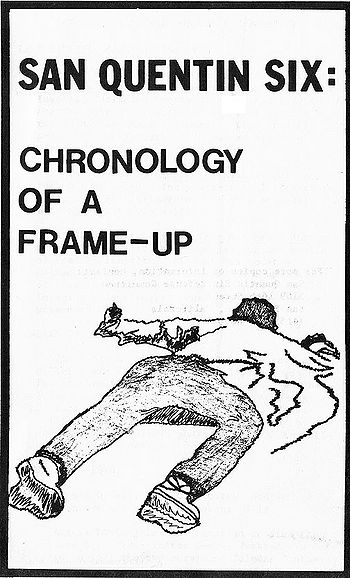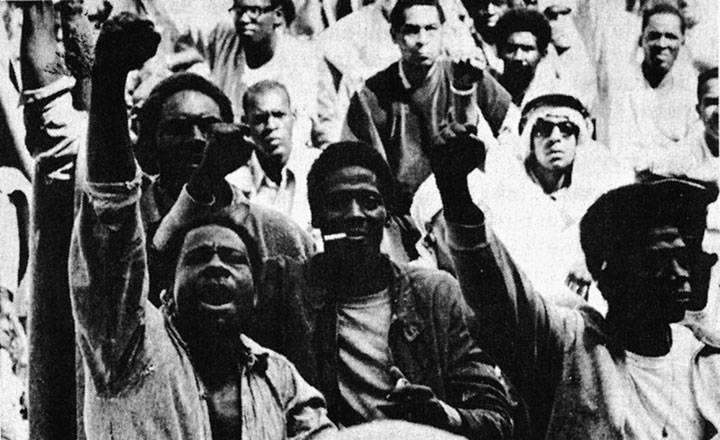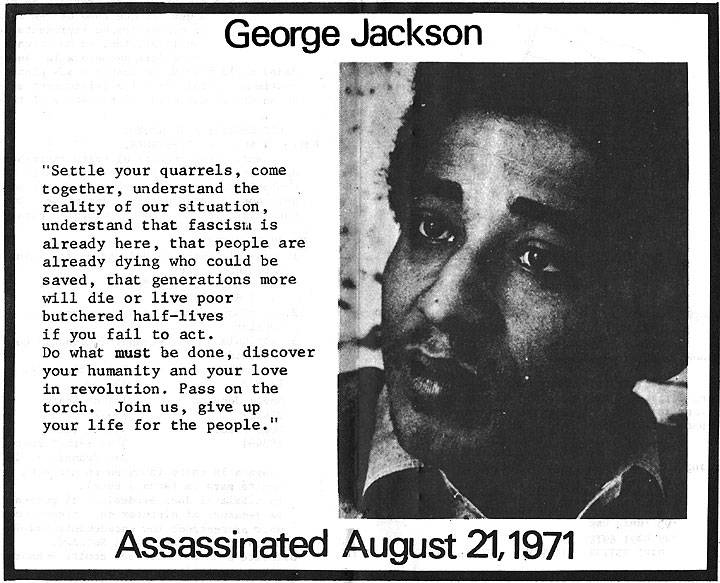San Quentin Six: Chronology of a Frame-up
Primary Source
Pamphlet published in 1975 by San Quentin Six Defense Committee
CHRONOLOGY OF SAN QUENTIN SIX FRAME-UP
LATE SIXTIES, EARLY SEVENTIES: Prior to the 1971 San Quentin Six indictments, Hugo Pinell and Fleeta Drumgb, along with fellow inmates, including George Jackson, had fought against prison authorities' attempts to whip up racial hatred among prisoners. They strongly protested the January, 1970 murder of three Black prisoners.
In November, 1970, Johnny Spain is put into the hole at Soledad for possession of literature alleged to be "inflammatory" — his personal writings about prison life.
At San Quentin, Willie Tate and David Johnson vigorously protest the fatal gassing and beating of Fred Billingslea. Also at San Quentin, Luis Talamantez successfully fights frame-up charges of assault, stemming from a March, 1970 incident in which Luis actually breaks up a fight among prisoners.
JANUARY 13, 1970 Three Black prisoners — Nolan, Edwards, and Miller — are killed by a Soledad prison guard. Two of them had been involved in a suit against Soledad, exposing the racist, hate-mongering tactics employed by prison officials. These killings are ruled "justifiable homicide" by the Grand Jury. A Soledad guard, O.G. Mill is killed shortly thereafter.
JANUARY 16, 1970 Fleeta Drumgo, John C1utchette, and George Jackson are accused of murdering Mills. Angela Davia joins the campaign to free the Soledad Brothers. (After George Jackson was murdered in 1971 the two surviving Soledad Brothers were acquitted of charges by a jury.)
AUGUST 7, 1970 Jonathan Jackson, younger brother of George Jackson, walks into the Marin County courtroom where a Black San Quentin prison activist, James McClain, is standing trial. McClain, Jackson, and inmate-witnesses William Christmas and Ruchell Magee take hostages. Jackson, McClain, Christmas, and Superior Court Judge Haley are killed.
Angela Davis and Ruchell Magee are subsequently accused of murder, kidnap, and conspiracy in connection with the above events. (Davis was acquitted in June, 1972. Magee was acquitted of murder, and there was a hung jury on the kidnap charges in March, 1973. In January of 1975 Magee was sentenced to life in prison on the basis of an alleged guilty plea.)
AUGUST 21, 1971 George Jackson is fatally shot in the back by ( prison guards at San Quentin. Two other inmates and three guards are also killed. In the days that follow, Adjustment Center (AC) inmates are beaten, shot, burned, and generally brutalized. Several contradicting stories are released to the press and public. For example:
—The "cap" under which Jackson is alleged to have hidden a pistol, which he is said to have smuggled into the prison after an attorney visit, changed to a "wig". The "thirty seconds" jackson was alleged to have spent shooting it out in the Adjustment Center (San Quentin's maximum security unit) is changed to twenty minutes.
—Authorities say that Jackson smuggled in a "9 mm Spanish Astra m-600" under an Afro wig. The San Francisco Chronicle had reporters re-enact the alleged feat and discovered it could not be done. After the Chronicle results were published, a new story was leaked in which the gun became a lighter and smaller Spanish Llama Corto. In the Grand Jury hearings it ended up as a 9 mm Astra.
—The exit wound in Jackson's back became an entrance wound.
SEPTEMBER 13, 1971 New York Governor Nelson Rockefeller orders the assault on insurgent Attica, resulting in the deaths of Attica prisoners and guards. Sixty prisoners are being prosecuted, yet no State or Federal officials are being charged.
OCTOBER 1, 1971 The San Quentin Six and Attorney Stephen Bingham are indicted for murder and conspiracy stemming from the events of August 21.
—The indictment is forced through despite objections and subsequent resignations of three Grand Jurors. One of 'the horrified Grand Jurors called the proceedings "fa1lacious and immoral". Another declared that "What this Grand Jury does is not justice but vengeance".
—Pre-trial hearings begin. The Six arrive in court chained, manacled, and shackled.
JANUARY, 1973 F1eeta Drumgo wins a pre-trial motion to have the court appoint and pay an attorney of his (Drumgo's) choice, but this ruling promptly is overturned by the California Supreme Court.
NOVEMBER, 1973 Howard Moore Jr., the only Black attorney in the San Quentin Six case, is cited for contempt by presiding Judge Henry Broderick for merely attempting to present an oral argument on a pre-trial motion he had just submitted in writng.
JANUARY 17, 1974 Superior Court Judge Vernon Stoll dismisses the murder-conspiracy indictments against the San Quentin Six on the grounds that the selection process of the Grand Jury excluded Blacks, Chicanos, Latinos, blue-collar workers, and youth as jurors. However by December, 1974, the San Francisco District Court of Appeals reverses this momentous decision thus reinstating the indictments against the Six.
JULY, 1974 The trial of the San Quentin Six's Civil Suit against the California Prison system charging cruel and unusual punishment begins. The trial exposes the brutality and misery inside the infamous Adjustment Center (AC). The Six demand that Federal Court Judge Zirpoli release them from the.AC and order the Department of Corrections to shut down the AC altogether.
DECEMBER, 1974 District Court of Appeals reverses the historic Stoll decision.
JANUARY, 1975 Willie Tate, one of the Six wins release on $500,000 bond after completing the final year of his original sentence. Release is won despite the "arbitrary high-handed maneuvers of the State Supreme Court to keep him in custody", in the words of Attorney Howard Moore.
JANUARY 29, 1975 California Supreme Court turns down the Six's request for a hearing, thereby affirming the San Francisco Court of Appeals' ruling which reversed Judge Stoll's decision. After 30 days, the original murder-conspiracy indictment against the Six is once again in effect.
FEBRUARY 21, 1975 Pretrial motions resumed with Judge Henry A. Broderick presiding.
MARCH 3, 1975 Hugo Pinell enters court with a patch over his left eye as a result of a beating by San Quentin guards. Johnny Spain appears with contusions on his left cheek. The beatings resulted from the brothers' protest at the lack of adequate medical care for ailing Johnny Spain.
MARCH 6, 1975 Arguments challenging the fairness and impartiality of the current jury selection process are heard. One by one, all of the defendants (with the exception of Willie Tate, free on bail) are ejected from court following their protests at Judge Broderick's refusal to hear defense arguments and at the 'lack of adequate medical care for ailing Johnny Spain.
San Quentin Six supporters during jury selection protest.
MARCH 14, 1975
By this date, Judge Broderick has denied:
1) a change of venue motion filed because of the inflammatory and prejudicial Marin County press;
2) a motion to sever the Six's cases from that of Stephen Bingham (white lawyer reported last in Canada, who is alleged to have passed a gun to George Jackson on Aug. 21, 1971);
3) appeals to remove the chains and shackles with which the Six are led like animals to and from court;
4) appeals to provide medical attention for Johnny Spain who must be periodically removed from the. courtroom because of agonizing muscle spasms and other undetermined illnesses.
MARCH 24, 1975: Judge Broderick affirms the prejudicial and unnecessary shackling and chaining of the Six during court sessions. He also refuses to entertain the motion to have himself removed as the presiding judge.
MARCH 25, 1975 The process of jury selection begins.
MARCH 26, 1975 Defense attorneys argue a motion demanding the judge order a mistrial because the slavery-day chaining and shackling of the brothers constitute an unquestionable violation of their fair trial rights. Motion denied.
—Bourgeois press circulates totally unfounded rumors that Hugo Pinell stabbed his court-appointed attorney, Lynn Carmen, in the throat.
—Carmen vehemently denies this vicious rumor while emphasizing that his throat bore no stab wounds of any sort.
MARCH 27, 1975 Defense Attorney Frank Cox files a dramatic and revealing motion charging that the D.A. is in possession of certain evidence which proves that prison authorities, along with the state, had foreknowledge of and aided and abetted in the events of Aug. 21, 1971. Motion to gain access to such evidence, including certain FBI files, is denied.
APRIL, 1975 Jury selection continues. Existence of "secret witness" revealed by prosecution. In spite of defense attorneys' rightful insistence that this person's identity be revealed, so that an adequate defense might be prepared, Judge Broderick orders that this witness remain anonymous until 21 days before he/she testifies.
MAY 6, 1975 Only remaining Black juror out of 600 called to this date is preemptorily dismissed (without cause) by the prosecution. Fleeta Drumgo and David Johnson are ejected from the court after vociferously protesting.
MAY 8, 1975 In what appears to be an attempt to justify the racist removal of the only Black juror from the jury box, prosecutor Herman charges that one of the defense investigators, Victoria Mercado, had been seen talking to Ann Smith (a prospective juror) twice prior to her dismissal. Ms. Mercado is tried for jury tampering; a ruling is not expected before the end of the trial.
MAY 19, 1975 Johnny Spain is excused from court and taken to S.F. General Hospital for medical tests. He is chained to the hospital bed and surrounded by heavily armed SQ guards. A few days later, Johnny is snatched from the hospital by prison authorities over his doctor's strong objections. Despite much protest, Johnny was not returned to the hospital and still suffers from an undiagnosed ailment.
JUNE, 1975 Jury selection continues.
JULY, 1975 By mid-July Jury selection is complete. Of 12 jurors, eleven are white and one black. (Of a total of 1400 in the jury pool, only 8 were Black. Although Marin County has a 2.5% Black populace, only .57% of all jurors called were Black.)
JULY 14, 1975 Luis Talamantez, David Johnson, and Hugo Pinell are beaten, gassed, chained and dragged from their Adjustment Center cells, and appear in court reeking of gas and covered with bruises. The assault by prison guards was the result of a direct order by Judge Broderick that Luis Talamantez be placed in the court's holding cell as "punishment" for objecting to Broderick's ruling during a previous court day, that one of Luis' counsel, Ernest Graves, could not question an obviously prejudiced prospective juror.
JULY 28, 1975 Prosecution begins opening statement. D.A. Jerry Herman admits that there is no direct evidence that any of the six actually killed any of the guards or inmates on August 21, 1971, and that he would have to rely on conspiracy theories of aiding and abetting in order to convict. San Quentin Six Defense Committee and other supporters hold demonstration to protest injustices, chaining and shackling of the defendants and the seating of a jury of non-peers.
AUGUST 1, 1975: Following the landmark U.S. Supreme Court decision which upheld the right of defendants to act as their own counsel, Hugo Pinell submits a motion to be allowed to act as his own counsel.
AUGUST 7, 1975 Hugo Pinell granted the right to be his own counsel but would not change the ruling to remove the chains and shackles. San Quentin guard Daniel Scarborough, a prosecution witness, testified under cross-examination that he saw a letter in November or December of 1970 from the FBI alerting the prison of the smuggling plan.
AUGUST 9, 1975 A political-cultural event hosted by the San Quentin Six Defense Committee in memory of James McClain, Jonathan Jackson, William Christmas and other fallen comrades.
AUGUST 15, 1975 Another people's victory—Joan Little freed. Joan Little, young black woman freed of second degree murder charges.
AUGUST 16, 1975 San Quentin officials release to the public that all Adjustment Center guards are to be searched prior to admittance.
AUGUST 17, 1975 San Quentin officials issue to the public a statement that a Black Panther Party leader Elaine Brown brought cocaine to the prison when she visited Johnny Spain on August 3rd. (Elaine Brown did not visit Johnny Spain on that day according to . prison records and Black Panther Party release.)
AUGUST 18-20, 1975 Kenneth McCray, the only witness against Talamantez testifies that he overheard Luis Taiamantez' conversation in Spanish with defendant Hugo in which he said Talamantez complained that a cord being used to strangle another guard was not tight enough. Under cross-examination by Robert Carrow, Luis' counsel, he stated that he could not remember what was said. Bernard C. Betts admitted that he did not see any weapon in the attache case or tape recorder when. he examined the objects. Daniel P. Scarborough testified that he saw a letter from the FBI in November or December of 1970 giving the prison foreknowledge of the escape. Sterling John Unangst said on the stand that there is no way for an escape to be arranged through the mail.
AUGUST 21, 1975 Fourth anniversary of George Jackson's murder by San Quentin guards. Vigil held by San Quentin Six Defense Committee outside trial site amidst heavy FBI and Marin County Sheriff surveillance. Kenneth McCray, the sergeant in charge of the Adjustment Center on that day admits that. he was carrying a pen knife at the time his throat was cut. He said, "just about everybody who worked at the prison had a small knife of some kind." Five knives belonging to guards among which was a switchblade were recovered after the August 21st incident. Although possession of a switchblade is a misdemeanor and possession of such weapons inside prison is a violation, no prison employee has been prosecuted or disciplined. Bombing of two Marin Sheriff cars at the site of the trial purported to have been done by the New World Liberation Front as an expression of solidarity by the underground. The cars were empty.
WHY THE SIX NEED YOUR SUPPORT The San Quentin Six are not treated by the State as men, but as animals and slaves. All six men have been living in the San Quentin AC for almost 4 years. They live in 6' by 8' cells, sleep on steel slates, are permitted no outdoor exercise, and are not allowed to participate in the prison's educational or vocational programs. Medical care is almost non-existent. Every time they leave their cells they are locked in an intricate network of chains and manacles and shackles, including neck chains. The intention of the slavery-day chaining and other unreasonable and excessive security measures in court is clearly to make it appear that these brothers are dangerous criminals, thus driving over the constitutional right to presumption of innocence.
The San Quentin Six are prime targets of brutality, harassment and frequent threats by prison guards because they have chosen to stand up and organize against their extreme oppression as Black and Brown prisoners.
During the trial of their Civil suit against the Department of Corrections all of the Six dramatically testified that they had been gassed, harassed, beaten, and tortured by guards. Several were told by guards that they would never leave the AC alive. During the trial itself, Johnny Spain came to court one morning with a bloodied jacket — he had been forcibly shaved by guards.
THE SAN QUENTIN SIX ARE VICTIMS OF A. POLITICAL AND FASCIST CONSPIRACY ORIGINATING FROM THE HIGHEST LEVELS OF STATE GOVERNMENT.
The beatings, chainings, constant threats, and the repeated denial of fundamental human and . democratic rights, coupled with the various contradictory official versions about the events of August, 1971 at San Quentin, and the lack. of any real evidence against the Six leads a reasonable person to one conclusion — that the State is attempting to silence the Six. Why? Because like George Jackson, the San Quentin Six have become outspoken representatives of the movement behind the walls, a movement which poses a real threat to the continued rule of prison authorities by racism and terror.
THE SAN QUENTIN SIX NEED YOUR SUPPORT. YOU ARE 'THEIR HOPE. When you fight against the inhumane and undemocratic treatment to which the San Quentin Six are'subjected, you are standing up for your rights and the rights of all prisoners and oppressed people. A victory for the Six would mean a victory for all prisoners and all progressive people.
<iframe src="//player.vimeo.com/video/100361380" width="500" height="375" frameborder="0" webkitallowfullscreen mozallowfullscreen allowfullscreen></iframe>
George Jackson and Angela Davis, among others, interviewed in 1970-71 prior to George Jackson's murder.
Video: George Jackson archive at Freedom Archives
San Quentin Six archive at Freedom Archives




